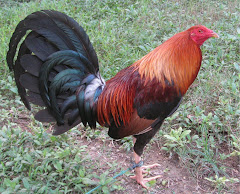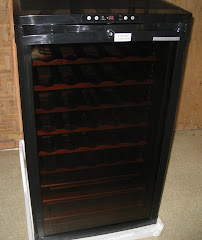Sunday, November 1, 2009
Llamado Tayo: Ang Lemon
Una po humihingi tayo ng paumanhin sa lahat na mga may katanungan na di natin nasagot. Medyo busy po kasi tayo sa stag derbies at paghanda sa susunod na breeding season. Sinasagot parin natin hanggat makakaya. Kaya lang pinipili natin ang mga mahahalaga at nangangailangan ng madaliang pagtugon. Maraming salamat po sa inyong pagunawa. Magpatuloy lang magbasa ng Larga at mag monitor palagi sa tilaok.blogspot.com.
Kasagsagan kasi ngayon ng mga stag derbies ng mga asosasyon. Dito samin sa Cebu patuloy ang stag circuit ng Central Visayas Breeders Association (CVBA) at ng Cebu Gamefowl Breeders Association (CEGBA). Nagumpisa narin po ang Heritage Cup eliminations sa Cebu. Sa susunod nating pitak ay malalaman na natin ang mga resulta. Sa pagsulat kasi natin nito ay last day of elimination pa ng Cebu series ng Heritage Cup.
Hinggil naman sa Masang Nagmamanok (MANA) patuloy ang mga ginagawa nito para sa mga karaniwang sabungero. Inaasahan na sa susunod na taon ay makakaarangkada na ng husto ang ating gamefowl dispersal program. Sa tulong ng RB Sugbo Gamefowl Technology, Mila farm, Garces Bros, Scorpion Ox at ibang pang mga kamana natin na breeders ay mas lalaki ang production capability ng MANA gamefowl dispersal farms. At may mga kumpaniya din ng feeds at gamot na tutulong satin sa proyektong ito.
Napagpasiyahan kasi ng national board ng MANA na tumutok sa mga proyekto na may direktang benepisyo na mapupunta sa mga kamana. Kabilang dito ay ang technology transfer o pagtuturo ng kaalaman sa pagmamanok, at ang gamefowl dispersal. Kasi aanhin ang kaalaman kung di naman kayanin ng mga kamana natin ang halaga ng breeding materials ng manok. Mga proyektong ganito muna ang tutukan ng MANA, hindi muna ang mga pasabong at baka akalain ng publiko na ang MANA ay sa aspeto lang ng pagsusugal nakatuon ang pansin. Ang pagsusugal ay isang aspeto sa sabong na hindi maiiwasan. Ngunit ito'y isang aspeto lang. Marami pang ibang aspeto ang sabong at ang pagmamanok na may maidudulot na maganda. Halimbawa ang katotohanan na ang pagmamanok ay mapagkakitaan, at hindi ka kailangan na magsugal upang gawin ito. Ito ang mas bigyan natin ng pansin.
Ngunit ang totoo ang pagsasabong ay hindi maiiwasan. Dahil ito ang dahilan kung bakit may gamefowl industry na napakalaki ngayon dito sa Pilipinas. Kung walang sabong wala sanang sabong industry. Kaya inaanyayahan natin ang lahat sa pasabong ng MANA Luzon sa Pasay Cockpit ngayong Oct. 21 at ng MANA Cavite sa December 15 sa Arcontica Col.
Ang susunod po ay bilang tugon sa mga nag-request na ilathala naman natin ang history ng iba pang uri ng lemon. Bahagi po ito ng "The Philippine Lemon" na isinulat natin para sa Pit Games.
The lemon guapo
Another strain of lemon that has been around for more than 30 years is the lemon guapo of Mayor Juancho Aguirre.
According to mayor Juancho in the sixties and the 70s Negros was full of so-called lemon lines. There were the 84, the batchoy, the togo , the massa , and the hinigaran, to name a few. The 84 was Paeng’s creation. Batchoy and massa were name of the breeders who originated these lines, while Hinigaran is the place of Freddie Yulo, who had been the Negrenses’ foremost source of hulsey lemon cocks.
At that time most Negros breeders, including the group of Mayor Juancho, did not have the technical knowledge and support that present day breeders enjoy. For them, it was, almost always a hit and miss affair. Thus, they really had a hard time producing good birds, much less maintain their winning lines.
Indeed, it was the reason, mayor Juancho said, that they sponsored the Duke himself to stay in Negros for a while to teach them the rudiments of breeding and fighting.
Because of this lack of scientific knowledge, coupled with the fact that the breeders also failed to assess accurately the value of these lemons, most of these lines either went to extinction or took the back seat.
The 84s and the batchoys are still around. The massa and togo are no longer heard of. The hinigaran has reincarnated as the Guapo line.
Here is the story:
At about the time, Paeng’s 84s were making waves, disaster hit mayor Aguirre’s stock. Avian pest wiped out his flock. Among, the very few survivors were a lemon brood cock and a baby stag that was suffering from a limber neck as result of barely surviving the epidemic.
Discouraged and decided to take a leave from breeding, the mayor gave the brood cock to his brother-in-law Bob Cuenca who had a lot of the same lemon strain- the hinigaran variety.
Mayor Juancho also gave the surviving limber necked hinigaran lemon baby stag to a kumpadre who peddled chickens.
After a year, the mayor casually asked his kumpadre about the limber necked stag. To his surprise, the limber neck was not only fine but indeed was a very beautiful specimen of a cock.
They started calling it guapo. After a while they fought guapo. It won four fights practically unscathed. On its fifth win guapo was badly wounded.
Mayor Juancho, whose interest in breeding had been slowly revived, decided to breed guapo. He bred the erstwhile limber neck to some cecil hens and some hatch hens.
He kept breeding the best pullets back to guapo, at the same time employ some brother-to-sister matings, until he was able to set the strain he called lemon guapo.
“I continued to play around with many inbreeding variations of the guapo line, always keeping in mind absolute quality control,” Mayor Aguirre told this writer.
Eventually the line with the infusion of the cecil blood was discontinued because according to him the cecils tend to produce oversized offspring. (The cecils referred to were not of Cecil Davies bloodline but a line of Duke Hulsey which Duke called as such. They were reds with white under hackles.)
The malatuba family of the guapo
After almost forty years of playing around with the guapo bloodline, suddenly a bunch of the present day guapos came out malatuba or pumpkin in plumage.
These pumpkins are direct decendants to a guapo lemon that had just recently died but not before reaching the age of nine. According to mayor juancho, this particular cock became a hennie or binabaye after its last moult.
He consulted veterinarians on the phenomenon. All they could say was that it could be a result of altered hormone balance as brood cocks were normally pumped with hormones to induce fertility.
How about the bunch of pumpkin guapos? They could not be result of hormone imbalance. They could only be throwbacks.
The pumpkins came out of a likewise pumpkin cock that is son to the old lemon-turned- binabaye brood cock. This pumpkin lemon broodcock could be a case of “throwback beyond the original.”
The original hulsey cocks brought to the country in the sixties were not malatuba. The throw back must be way way back to their earlier predecessors. Perhaps, somewhere along the line long before the hatch-claret-butcher lines were blended by Duke Hulsey, any one or more of the said bloodlines carried some pumpkin genes. I suspect it must have been the clarets.
According to the History of Game Strains (Johnson and Holcomb) in 1927, a Duryea cock which was thrown in to contribute to the development of the claret bloodline, produced many wonderful pumpkin cocks.
This could be the reason why Juancho’s lemon guapo is now producing pumpkin throwbacks. And, their fighting styles? Well, JGA’s pumpkin lemon guapos are the most powerful lemons I’ve seen. And, they still fight like lemons should—smart and quick.
Joe Laureño and the batchoys.
The batchoy lemons were among the first lemon lines that made it to the big time. They were straight combed, lemon hackled low stationed cocks and originated by the late Batchoy Alunan. Unknown to many then, there was one other man behind the success of the batchoys—Joe Laureño, Mr Alunan’s trusted chickenman.
Batchoy Alunan died in 1980. Now 25 years after, the batchoys, in their original state, are very much alive in the farm of Joe Laureño.
Joe had been associated with Batchoy from 1968 to the latter’s death in 1980. As a parting gift from the family, he was made to settle for some fowl instead of cash. From then on, the burden of preserving the batchoy lines fell upon Joe’s shoulder.
According to Joe, he got 2 broodcocks and 13 hens. Out of these, he had managed to reconstruct the batchoy bloodlines.
Joe told Pit games that there were actually three kinds of lemon in the batchoy yards. There was the 84, the left ins and the line that was called the batchoys. Of course there were also other bloodlines such as the equally formidable batchoy greys.
The line called batchoy is low stationed and very barako. This particular batchoys were tough and they fought like hatches. The left ins were beautiful and were the smart ones. The blend of the two lines gave them numerous successes then, along with Francis de Borja and Jesse Cabalza, who were foremost chicken fighters of the time.
The 84s really came from the original 84 cock. The original 84 cock was with Batchoy Alunan for a while and Joe bred it to some of their own lemons.
With just the 2 cocks and 13 hens, Joe did not only manage to restore the batchoys, he was also able to discover blends that made his lemons comparable to the best of the best bloodlines of today.
How did he do it?
Joe did it with the time-honored method of back crossing to the purer parent, and other forms of in-breeding. Of course, he also resorted to the inevitable infusion of new blood at some point. New bloods that were eventually slowly bred out in order to once again purify the lemon blood.
He has fought them crossed with several different bloodlines with same success-- in the bakbakan, in the world slasher, and in many great gathering of great feathered warriors.
As most of us know, Joe is very active in the big times nowadays. He is now among the country’s big boys. Joe and his son Johnny have won the prestigious Balbina Breeders Cup twice already.
The entry JVL is always in the thick of the big fights. Where and when the best chickens of the land see action, Mang Joe and his fowl are there to reckon with.
In his very beautiful farm that this writer visited, there was an array of imported dink fairs sweaters, yellow legged hatches, Roger Robert’s hatchets, mcleans and other hatches. Yes, there were some two thousand beauties on cord. Amid these jewels, still were the batchoy lemons of the old. Not so beautiful, but so precious.
Welcome. To read the articles, please click post link or month, then subsequent post link.
-
▼
2009
(71)
-
▼
November
(9)
- MANALU sets feeding of street children
- Gamefowl's natural biorhythm: A study by RB Sugbo ...
- Probiotics for chickens
- Llamado Tayo: Sugbo Agro
- Llamado Tayo: Malungkot na pangyayari
- Llamado Tayo: Ang Lemon
- Llamado Tayo: Iba ang Pinoy
- Llamado Tayo: Sa sabong hindi sugal ang mahalaga
- Llamado Tayo: 3 cocks sa Baras, Rizal
-
▼
November
(9)
Ponkan broodcock

One of the ponkan broodcocks being readied by RB Sugbo for the incoming breeding season. RB Sugbo is among the gamefowl farms very much involved in the Masang Nagmamanok (MANA) Inc. nationwide gamefowl dispersal program.
Another ponkan

Another ponkan broodcock in the trio pen.
Mana: Dami at Pagkakaisa
Walang duda napakalaki na ng pinagunlad ng sabong mula sa paging libangan tuwing araw ng Linggo, ito ngayon ay isa nang napakatanyag na isport, malaking industriya at kaakitakit na mapagkakitaan.
Napakarami nang nagpapalahi ng manok panabong. Nagsilabasan ang mga babasahin at programa sa telebisyon ukol sa sabong.
Sa bawat nagpapalahi, ilan ang tagapagalaga ng kanyang manok? Sa bawat may-ari ng sabungan, ilan ang naghahanapbuhay sa sabungan niya? Sa bawat kasali sa derby, ilan ang nagbabayad sa pinto upang manood? Sa bawat malaking sabungero, ilan ang mayroon lang iilang pirasong tinale sa kanilang bakuran? Dapat lang, at napapanahon na siguro, na ang masang sabungero ay mapagtuonan ng pansin, mabigyan ng kinatawan, at, marinig ang boses sa isport at industriya ng sabong.
Ito ang nais abutin ng MANA (Masang Nagmamanok), isang pambansang kilusan at samahan ng mga masang sabungero. Ang mga layunin ng MANA ay ang sumusunod:
1. Ang pangalagaan ang kapakanan ng mga maliit na sabungero, partikular na, ang mga naghahanapbuhay sa sabungan. Inaasam na sa darating na panahon, ang mga handlers, mananari, casador, kristos, sentensiyador, farm hands ay magkakaroon ng mga benepisyo tulad ng insurance, pension at iba pa.
2. Ang mapatingkad ang kaalaman ng ordinaryong sabungero sa pagmamanok. At, sila’y mabigyan ng pagkakataon na magkaroon ng angkop na materyales sa pagpapalahi at paglalaban.
3. Ang ipaglaban ang sabong sa gitna ng banta na itoy gawing labag sa batas tulad ng nangyari kamakailan lang sa Estados Unidos, at ipreserba ito bilang isport, hanapbuhay, industriya at bahagi ng ating kultura at tunay na mana.
4. Ang magtulungan at makipagtulungan sa iba pang haligi ng industriya sa ikabubuti ng sabong at ikauunlad ng lahat na mga sabungero.
Inaasahan na matupad ng MANA ang nasabing mga layunin pamamagitan ng pagpakita ng dami at pagkakaisa.
Ang pagkatatag ng MANA ay bunsod ng mungkahi ni kamanang Boying
Ang Llamado Tayo ay tumatalakay sa ibatibang aspeto sa pagmamanok at binabasa ng napakarami arawaraw, kaya di nagtagal marami ang sumapi sa MANA.
Kasunod nito, ang MANA ay nakapagpaseminar sa ibatibang lugar at rehiyon ng Pilipinas, sa tulong ng mga kumpaniya tulad ng Excellence Poultry & Livestock Specialist, Bmeg-Derby Ace, Sagupaan, Secret Weapon, at Thunderbird.






